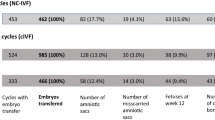Abstract
Luteal phases after in vitro fertilization (IVF) and embryo replacement have been studied in 241 cycles. A positive correlation was observed between the follicular estradiol (E2) peak and the progesterone (P) level on day 3 of the luteal phase, but not correlation was found between the E2-peak value and the luteal-phase duration or midluteal P concentration. When the trials were classified in relation to their outcome (i.e., clinical pregnancies, chemical pregnancies, or failures), the mean P level on day 3 of the luteal phase was significantly higher in clinical pregnancies than in chemical pregnancies and in failures. Mean E2 levels on day 3 were not significantly different among the three groups. Values of the E2/P ratio were significantly higher in chemical pregnancies than in the other groups. No significant differences were observed among the three groups on day 8. When comparing trials ending in failure to those leading to clinical pregnancy for the same patients, pregnancies were obtained in cycles in which early luteal P was higher and the early luteal E2/P ratio was lower than in failures cycles. These data suggest that high P levels and a low E2/P ratio in the early luteal phase might have a favorable influence on the implantation process in human IVF.
Similar content being viewed by others
References
de Mouzon J, Lefèvre B, Frydman R, Belaish-Allart JC, Guillet-Rosso F, Testart J: Factors affecting humanin vitro fertilization: A multifactorial study. Fertil Steril 1985; 43:892–896
Camus M, Puissant F, Deweze-Van Hoeck J, Leoroy F: Development and quality of IVF trials. Abstracts Handbook-IVth World Conference onin Vitro Fertilization. Melbourne, Australia, Nov. 18–22, 1985
Frydman R, Testart J, Giacomini P, Imbert M, Martin E, Nahoul K: Hormonal and histological study of the luteal phase in women following aspiration of the preovulatory follicle. Fertil Steril 1982;38:312–317
Cohen J, Debache Cl, Pigeau F, Mandelbaum J, Plachot M, de Brux J: Sequential use of clomiphene citrate, human menopausal gonatropin in humanin vitro fertilization. II. Study of luteal phase adequacy following aspiration of preovulation follicles. Fertil Steril 1984;42:360–365
Garcia JE, Acosta AA, Hsiu JC, Jones HW: Advanced endometrial maturation after ovulation induction with human menopausal gonatropin/human chorionic gonatropin forin vitro fertilization. Fertil Steril 1984;41:31–35
Rosenfeld DL, Garcia CR: A comparison of endometrial histology with simultaneous plasma progesterone determination in infertile women. Fertil Steril 1976;27:1256–1266
Shepard MK, Senturia YD: Comparison of serum progesterone and endometrial biopsy for confirmation of ovulation and evaluation of luteal function. Fertil Steril 1977;28:541–548
Cumming DC, Honoré LH, Scott JZ, Williams KP: The late luteal phase in infertile women. Comparison of simultaneous endometrial biopsy and progesterone levels. Fertil Steril 1985;43:715–719
Testart J, Frydman R, Feinstein MC, Thibault A, Roger M, Scholler R: Interpretation of plasma luteinizing hormone assay for the collection of mature oocytes from women: Definition of a luteinizing hormone surge-initiating rise. Fertil Steril 1981;36:50–54
Englert Y, Puissant F, Camus M, Van Hoeck J, Testart J, Frydman R, Leroy F: Conditions du tranfert intrautérin et devenir des embryons. Rev Med Brux 1985;6:615–620
Dirnfeld M, Lejeune B, Camus M, Vekemans M, Leroy F: Growth rate of follicular estrogen secretion in relation to the outcome ofin vitro fertilization and embryo replacement. Fertil Steril 1985;43:379–384
Radwanska E, Swyer GIM: Plasma progesterone estimation in infertile women and in women under treatment with clomiphene and chorionic gonatropin. J Obstet Gynaecol Br Commonw 1974;81:107–112
Downs KA, Gibson M: Basal body temperature graph and the luteal phase defect. Fertil Steril 1983;40:466–468
Lenton EA, Landgren ED, Sexton L: Normal variation in the length of the luteal phase of the menstrual cycle: Identification of the short luteal phase. Br J Obstet Gynaecol 1984;91:685–689
Horta JLH, Fernandez JG, de Soto LB, Cortes-Gallepos V: Direct evidence of luteal insufficiency in women with habitual abortion. Obstet Gynecol 1977;49:705–708
Lenton EA, Adams M, Cooke ID: Plasma steroid and profiles in ovulatory but infertile women. Clin Endocrinol (oxford) 1978;8:241–255
Seppälä M, Lehtovirta P, Rutawen EM: Detection of chorionic gonatropin activity in infertile cycles with a short luteal phase. Acta Endocrinol (Kbh( 1978;88:164–168
Lenton EA, Sulaiman R, Sobowale O, Cooke ID: The human menstrual cycle: plasma concentrations of prolactin, LH, FSH, oestradiol and progesterone in conceiving and non-conceiving women. J Reprod Fert 1982;65:131–139
Yovich JL, McColm SC, Yovich JM, Matson PL: Early luteal serum progesterone concentrations are higher in pregnancy cycles. Fertil Steril 1985;44:185–189
Lejeune B, Dehou MF, Leory F: Tentative extrapolation of animal data to human implantation. NY Acad Sci (in press) 1986
Psychoyos A: Hormonal control of ovoimplantation. Vitam Horm 1973;31:201–256
Jones HW, Acosta A, Andrews MC, Garcia JE, Jones GS, Mahntzavinos T, McDowell J, Sandow B, Veeck L, Whibley T, Wilkes C, Wright G: The importance of the follicular phase to success and failure inin vitro fertilization. Fertil Steril 1973;40:317–321
Edwards RG:In The Current Clinical and Ethical Situation of Human Reproduction and Their Eugenic, Ethical Implications, CO Carter (ed). London, Academic Press, 1983
Karsh FJ, Krey LC, Weick RF, Diersahke DJ, Knobil E: Functional luteolysis in rhesus monkey: The role of estrogen. Endocrinology 1973;92:1148–1152
Board JA, Bhatnagan AS, Bush CW: Effect of oral diethylstilbetrol on plasma progesterone. Fertil Steril 1973;24:95–97
Lehman F, Just-Nastansky I, Behrendt B, Crygau PJ, Bettendorf B: Effect of postovulatory administered oestrogens on corpus luteum function. Acta Endocrinol (Kbh) 1975;79:329–336.
Author information
Authors and Affiliations
Rights and permissions
About this article
Cite this article
Lejeune, B., Camus, M., Deschacht, J. et al. Differences in the luteal phases after failed or successful in vitro fertilization and embryo replacement. J Assist Reprod Genet 3, 358–365 (1986). https://doi.org/10.1007/BF01133248
Received:
Accepted:
Issue Date:
DOI: https://doi.org/10.1007/BF01133248



